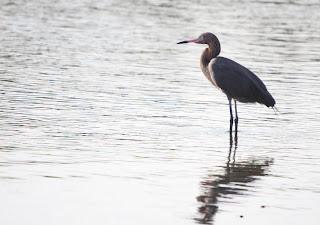I'm back from my week off. This was Spring Break at the College where I teach so I, of course, went to Florida. I wanted to get away from the cooler temperatures of New England so I went South for a week of Drunken Debauchery. Don't believe me? Darn. You know me too well. I went South for a week of bird watching and nature observing. Sound more likely?
We've been to South Florida before so we had an idea of where we wanted to go. Some of the best locations for wildlife viewing in the United States are located here. Of course the US has very little in the way of Charismatic Megafauna (the big, easily viewed animals you think of when you think of Africa) so we go for the birds and South Florida does not disappoint.
This is a Roseate Spoonbill (Ajaia ajaia). They are relatively elusive bright pink birds. Notice the shape of the bill? Turns out that the native pink bird of Florida is the Roseate Spoonbill and not the Flamingo. It's unclear if any Flamingos are or have even occurred "naturally." It's more likely they were all escapees fand their descendants) from captive populations. So one large pink bird with an odd shaped bill that was brought in as captive birds is the iconic bird of Florida while another large pink bird with an odd shaped bill actually is native.
We saw these at
Ding Darling National Wildlife Refuge on Sanibel Island. It's great for even the casual bird watcher. There is a four mile scenic drive through a Mangrove Swamp that is filled with long legged wading birds and plenty of opportunity to stop and get out (or to walk or bike, something we don't do with all of my heavy camera gear).
This Tricolor Heron (Egretta tricolor) posed very close to shore, catching small fish that came out of a culvert under the road where the water moved with the tides.
Here's a Reddish Egret (Egretta rufescens). This one was holding still. These birds hunt by dancing. They move rapidly through the water with wings spread. It's a sight to behold but not easy to photograph.
Waders weren't the only things we spotted in the area. This Hooded Warbler (Wilsonia citrina) was hunting insects along the shoreline. How often do you see warblers on the beach? Warblers are one of the later spring migrants since they are insect eaters. Warblers are very colorful, sing beautifully, and are hard to spot in the treetops.
OK. So not all Warblers are colorful and hang out in treetops. This warbler is an Ovenbird (
Seiurus aurocapillus). Ovenbirds spend a lot of time on the ground. We saw this one under the feeders at
Corkscrew Swamp Audubon Sanctuary. This is another good birding location that is easy for the casual birder to enjoy.
Corkscrew Swamp is a mixed habitat are with cypress swamp, pine forest and grassy fields.
They feed the birds so many birds come right up to the visitors center area (including a painted bunting that I did not get good photos of). This guy was under one of the feeders. Raccoons (Procyon lotor) can become major pests when they get used to getting easy food from people. The people at Corkscrew know this and are trying to figure out how to discourage the raccoon while still attracting ground feeding birds. It's quite a challenge.
Raccoon can carry several diseases that are transmissible to humans and pets. If you have raccoons in your area don't leave pet food out overnight, secure your compost and try to get a raccoon resistant bird feeder or hang your feeder so it's hard for the raccoons to get to.
Corkscrew Swamp was also home to numerous Brown Anoles (Anolis sagrei), an invasive exotic species from Cuba and the Bahamas that is competing with our native Green Anole (Anolis carolinensis). I was tempted to catch some up and bring them home but I didn't think I could catch enough to have a dent in their exploding population.
This big draw for us at Corkscrew were the Swallow-tail Kites (Elanoides forficatus). There was a great view of a nest from the boardwalk. You can see the flying kite carrying a stick.
The nest is in this photo behind the bird. He was launching off the nest. The sanctuary folks had a spotting scope set up so even if you didn't have your own binoculars you could get a good look at the nest.
One of the interesting things about the South Florida habitats is the prevalence of epiphytic plants. There are lots of plants that grow on trees and even the power lines. Here is a nice Tillandsia. There were also ferns, bromeliads, and Spanish moss.
Tillandsia Bloom
Epiphytes get the moisture and nutrients they need out of the air. In cooler climates lichens and mosses can grow ephiphytically.
Whew. There's a lot of stuff still to go. Let's call this posting Part I and I'll post Part II tomorrow. I still have laundry to catch up on, groceries, next week's lecture, checking out what happened in my garden this past week....

















































